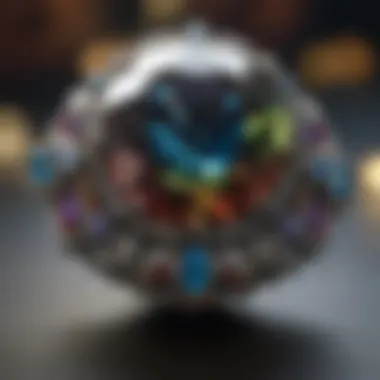The Birthstone for December 22nd: A Comprehensive Exploration


Intro
Birthstones hold a special place in human culture, intertwining history, geology, and spirituality. Each month of the year is associated with unique gemstones, believed to bestow certain attributes upon those born in those months. For individuals born on December 22nd, the birthstones are turquoise, tanzanite, and zircon. Understanding these stones not only involves knowing their physical characteristics but also recognizing their historical significance and cultural contexts.
In this article, we delve deep into the birthstones designated for December 22nd, unveiling their individual qualities, origins, and the effects they are alleged to have. From the tranquil blue of turquoise to the rich hues of tanzanite and the vibrant shades of zircon, each gemstone offers unique features that captivate gemstone enthusiasts. As we explore these stones, we will also touch upon their metaphysical properties, shedding light on how they fit into both ancient traditions and modern interpretations.
Gemstone Overview
Definition and characteristics
The birthstones for December 22nd include turquoise, tanzanite, and zircon, each distinguished by unique properties and characteristics.
- Turquoise: Known for its mesmerizing blue-green color, turquoise is an ancient stone cherished by various cultures worldwide. Its opaque nature makes it instantly recognizable, and it often features irregular veining due to mineral impurities. This stone is valued for both its beauty and its symbolic meanings of protection and healing.
- Tanzanite: This gemstone is a recent addition to the birthstone list, having been discovered in Tanzania in the 1960s. It exhibits a fascinating color range, from deep blue to violet, depending on the angle of light. The clarity and vibrancy of tanzanite make it highly sought after, particularly in the jewelry market.
- Zircon: Often confused with cubic zirconia, natural zircon comes in various colors, including blue, yellow, and colorless. Its brilliance and fire are similar to diamonds, giving it great appeal. The historical significance of zircon dates back for centuries, making it a valuable stone in both ancient and modern contexts.
Classification of gemstones
Gemstones can be classified based on several factors, including origin, appearance, and mineral composition.
- Natural Gemstones: These stones are formed through natural geological processes. Turquoise, tanzanite, and zircon fall into this category, each formed under unique conditions within the Earth.
- Synthetic Gemstones: Created in laboratories, synthetic stones mimic natural gemstones in appearance but do not have the same geological history. While they can sometimes present similar physical properties, they are not considered genuine gemstones.
- Organic Gemstones: These stones originate from organic processes, such as pearls and amber. Although they do not apply to December's stones, they represent another category within gemstone classification.
Understanding these classifications is essential for collectors and enthusiasts, as it shapes their appreciation for each gemstone's rarity and value.
"Each gemstone tells a story of the Earth's history, offering a glimpse into its depths and the conditions that shaped them."
In the upcoming sections, we will examine the physical and chemical properties of these December birthstones, along with their historical significance and cultural implications.
Preface to Birthstones
Birthstones represent more than mere decorative items; they embody rich history, cultural significance, and deeply personal values for individuals. The concept of birthstones has rooted itself across diverse societies, enhancing the appeal of gemstones beyond their physical appearance. Examining birthstones allows us to appreciate their role not only in jewelry but also as symbols of identity and emotion.
Understanding birthstones includes recognizing the historical, cultural, and personal significance attached to each stone. For many people, a birthstone serves as a talisman or a protective symbol. As we delve into this article, we will explore the three primary birthstones for December - turquoise, tanzanite, and zircon - revealing their unique characteristics, historical contexts, and potential healing properties.
This comprehensive exploration emphasizes how these stones interact with traditions and modern realities. The narrative encourages readers to contemplate why a particular stone may resonate with them personally, thus fostering a connection that goes beyond aesthetics.
Understanding Birthstones
The term "birthstone" refers to gemstones that are traditionally associated with the months of the year. Each month has one or more stones that hold unique meanings, energies, or beliefs related to the people born during that period. This practice dates back several centuries and is still prevalent in contemporary culture.
The allure of birthstones lies in their perceived powers. It is believed that these stones can bring luck or wellbeing to the wearer. Birthstones serve as thoughtful gifts that encapsulate the personality and character of the recipient.
In modern use, December's birthstones—turquoise, tanzanite, and zircon—offer varied options that reflect individual tastes and preferences. This diversity allows for personal expression tied to significant traditions.
Historical Context of Birthstones
The origins of birthstones can be traced to ancient civilizations. The twelve stones mentioned in the Bible's Book of Exodus suggest a link exists between gemstones and the twelve tribes of Israel. Each tribe was associated with a different stone, creating the foundation for what we now recognize as birthstones.
Over time, this concept evolved through different cultures. The modern calendar of birthstones, established in the early 20th century, further defined each month’s associated gemstone. This shift made birthstones more accessible to the general public, supporting the idea of wearing gems for luck and protection.
The historical significance of birthstones reveals how they have been valued over time, marking important milestones in life. From celebrations to commemorations, these gems have remained relevant in expressing emotions and marking life's emotions.
Birthstone for December
The birthstone for December has a rich significance. It encompasses several gemstones including turquoise, tanzanite, and zircon. Each of these stones carries distinct properties and historical context, making December a unique month for those celebrating birthdays.
These stones are not merely decorative; they have been cherished for their beauty and attributed qualities throughout history. Understanding December's birthstones involves recognizing their physical traits, symbolism, and the cultural narratives woven around them.
Born under this month, individuals may find meaning in the characteristics of their unique birthstones, enhancing personal connections and self-expression through jewelry and other forms of adornment.


Overview of December Birthstones
December's birthstones come with three principal players: turquoise, tanzanite, and zircon. Each stone presents a vibrant color and distinct allure. Turquoise, known for its striking blue hues, has been valued since ancient times for both its beauty and healing properties. Tanzanite, a relatively recent discovery, displays a deep violet-blue that captivates gemstone collectors and jewelry designers alike. Zircon, on the other hand, is often overshadowed but offers impressive brilliance and a range of colors, often confused with cubic zirconia but possessing a unique identity.
Together, these three gems provide a narrative that is historical and colorful. Their properties can inspire and motivate individuals connected to this birth month.
The Importance of December 22nd
December 22nd is particularly significant, marking the transition into the winter solstice. This day, associated with longer nights and the returning light, has implications not just astronomically but also culturally. In various traditions, the date signifies renewal and new beginnings, which is an essential aspect when relating to birthstones.
Individuals born on this day may feel a deeper resonance with their birthstones. Turquoise, often linked with healing, encourages seeking balance and tranquility. Meanwhile, tanzanite can symbolize transformation and spiritual awareness, while zircon embodies wisdom and wealth.
This date also represents a moment of reflection and anticipation, as the end of the year approaches. Embracing these stones can be a reminder to honor personal growth and value the interconnectedness of one's journey.
Turquoise: The Primary December Birthstone
Turquoise holds a significant position as the primary birthstone for December. Revered not only for its stunning appearance but also for its rich history and cultural resonance, it offers a unique blend of aesthetic and metaphysical qualities. When exploring the December birthstones, turquoise emerges as a symbol of protection and healing, cherished by various cultures throughout history. Understanding its properties, significance, and uses guides gemstone enthusiasts toward a deeper appreciation of its varied attributes.
Properties of Turquoise
Turquoise is characterized by its unique color, often described as a vibrant blue or blue-green. This coloration is due to the presence of copper and aluminum within its structure. Its matrix can exhibit fine veins of brown or black, which adds a distinct pattern to each stone. The hardness of turquoise falls between 5 and 6 on the Mohs scale, making it somewhat soft and prone to scratching, hence requiring gentle care in jewelry design.
Some additional characteristics include:
- Translucency: Ranges from opaque to semi-translucent, enhancing its visual appeal.
- Formation: Primarily forms as a secondary mineral in copper deposits, often found in arid environments.
- Treatments: Natural turquoise can undergo treatments to enhance color and durability, though untreated stones are highly valued.
Turquoise is not just appreciated for its looks; its unique properties also attract gemologists and collectors alike.
Historical Significance of Turquoise
Historically, turquoise features prominently across many civilizations. In Ancient Egypt, it was seen as a sacred stone, often found in burial artifacts. The Egyptians believed it connected the heavens to the earth, indicating protection for the deceased. It also adorned the crowns of pharaohs, emphasizing its royal connections.
In Native American cultures, turquoise holds a deep spiritual meaning. The stone is associated with healing and protection, integral to numerous rituals. Different tribes used turquoise in their jewelry, believing it to offer strength and fortitude. Its historical significance extends globally, being utilized by various cultures, including the Persians and Chinese, for both ornamentation and as talismans.
"Turquoise has been revered as a gemstone for thousands of years, symbolizing protection and connection to the divine across diverse cultures."
Cultural Uses of Turquoise
Turquoise's cultural uses are as varied as its historical significance. Many cultures incorporate it into jewelry, often adorning necklaces, bracelets, and rings. This gemstone is particularly notable in southwestern Native American jewelry, where intricate silverwork complements its vivid hues.
Beyond jewelry, turquoise appears in art and decor. Groups often carve it into figurines or inlay it within ceremonial items, reflecting its importance in spiritual practices. Here are some specific cultural applications of turquoise:
- Amulets and Talismans: Used to ward off negative energies and enhance one’s health.
- Ceremonial Items: Integral to rituals and ceremonies, representing balance and harmony.
- Artistic Expression: Many artisans utilize turquoise in arts and crafts, signaling both heritage and contemporary relevance.
Understanding the properties, significant historical context, and cultural uses of turquoise enriches our knowledge of this precious stone. It illustrates not just a physical beauty, but a profound connection to our past and present.
Tanzanite: The Modern Birthstone
Tanzanite represents a fascinating chapter in the story of birthstones. Associated primarily with December, this gem has gained recognition for its unique beauty and vibrant colors. Its modern introduction to the world of gemstones contrasts with the ancient roots of other December birthstones like turquoise and zircon. This section focuses on the elements that define tanzanite, its significance, and what considerations should be made when exploring this gem.
Discovery and Origins of Tanzanite
Tanzanite was discovered relatively recently in 1967 by a man named Manuel d'Souza in the Merelani Hills of Tanzania. This location remains the only known source of tanzanite, making it exceptionally rare. Initially, the stone was dubbed "blue zoisite," but it was later renamed tanzanite by Tiffany & Co. to highlight its origin. The vivid blue and violet hues quickly captured the attention of gem enthusiasts and collectors alike.
The process of obtaining tanzanite is labor-intensive, requiring skilled gem miners to navigate through difficult terrain and sometimes hostile conditions. Mining operations are critical to sustaining this unique gemstone's availability in the market. Importantly, although tanzanite can be found in various shades, the deep blue variants are the most sought after, vibrant and highly valued.
Physical Properties of Tanzanite
Tanzanite is known for its striking colors and distinct characteristics. Its chemical composition is that of calcium aluminum silicate, which contributes to its mesmerizing hues. Here are some key physical properties of tanzanite:


- Color: Tanzanite exhibits a range of colors from blue and violet to burgundy. The stone’s pleochroism allows it to show different colors depending on the viewing angle.
- Hardness: On the Mohs scale, tanzanite ranks between 6 and 7. This level of hardness makes it suitable for many types of jewelry, though care must be taken to avoid scratches.
- Clarity: Unlike many gemstones, tanzanite may contain internal inclusions. Clarity varies widely, affecting its value, especially if the inclusions are visible to the naked eye.
Given these properties, tanzanite transforms into a versatile gem that jewelry designers appreciate. It can be set in various styles, appealing to a wide range of tastes.
Symbolic and Cultural Meaning of Tanzanite
Tanzanite's symbolism is deeply rooted in its unique origins. It is often seen as a stone of transformation and change, which resonates with those born in December. Culturally, tanzanite is affiliated with the notion of spirituality and healing—it is said to open the third eye, enhancing intuition and insight.
In the modern context, tanzanite is associated with peace and self-reflection. Many believe it helps to connect the physical and spiritual worlds. Additionally, the rarity of tanzanite mirrors aspirations for life’s precious moments and achievements.
Tanzanite is not just a pretty stone; it is a manifestation of deeper meanings, making it even more important for collectors and gem enthusiasts who value both the aesthetic and symbolic aspects of their stones.
"Tanzanite: A gem that whispers secrets of transformation and intuition."
Overall, tanzanite’s discovery, physical properties, and symbolic meanings contribute to its status as a modern birthstone that captivates the hearts of many.
Zircon: An Ancient Birthstone
Zircon is a gemstone that carries a wealth of ancient history and significance. This section explores its unique characteristics, historical context, and cultural implications. As the December birthstone, zircon offers both aesthetic and metaphysical value, making it an interesting topic for gem enthusiasts and collectors alike.
Characteristics of Zircon
Zircon is known for its remarkable optical properties and vibrant colors. It can be found in shades ranging from clear and colorless to blue, green, yellow, red, and brown. Notably, the blue hue is particularly sought after and resembles the more well-known blue topaz. One of the distinctive traits of zircon is its brilliance and fire, often attributed to its high refractive index, which allows it to exhibit a sparkly appearance comparable to diamond.
In addition to its visual appeal, zircon holds significant physical properties. It has a hardness rating of between 6 and 7.5 on the Mohs scale, making it durable enough for jewelry but requiring care to avoid scratching. Its natural occurrence can be found in metamorphic rocks and alluvial deposits, allowing it to be sourced from various parts of the world.
Zircon in Historical Context
Historically, zircon has been used for thousands of years. The ancient Persians considered zircon a powerful stone, believing it offered protection during travel. Furthermore, zircon has been discovered in historic artifacts, illustrating its long-standing allure. It played a role in the jewelry of many cultures, including the ancient Greeks and Egyptians. In these civilizations, zircon was often associated with attributes of wisdom and prosperity.
The term "zircon" itself is derived from the Persian word "zargun," meaning "gold-colored," which reflects its varied appearances. Over centuries, it has been mistaken for other gemstones due to its diverse colors and forms, contributing to its storied past in the realm of gemology.
Cultural Implications of Zircon
Culturally, zircon holds significance in various traditions around the world. In many cultures, it symbolizes fidelity and trust. It is often gifted during anniversaries and meaningful occasions to express these sentiments. Moreover, it has been associated with healing properties in alternative practices, believed to bolster mental clarity and promote a calm mind.
Zircon's relevance extends beyond traditional beliefs. Modern practitioners value it for its supposed ability to enhance creativity and self-expression. As a birthstone for December, it resonates with those born in this month, believed to evoke a sense of identity and self-awareness.
Metaphysical Properties of December Birthstones
The exploration of metaphysical properties associated with December's birthstones is essential to understanding how these gems can be perceived beyond their aesthetic appeal. Turquoise, tanzanite, and zircon each come with a unique set of beliefs and attributes, often utilized in various practices aimed at healing and spiritual growth. These properties invite deeper reflection on how individuals can incorporate these stones into their lives, influencing emotional and spiritual well-being.
Healing Properties and Beliefs
Each December birthstone carries specific healing properties that enthusiasts often seek. For instance, turquoise is believed to foster healing and protection. Many cultures regard it as a sacred stone that enhances communication and self-awareness. Individuals often wear it during moments of uncertainty, seeking guidance and clarity.
Tanzanite’s vibrant hue is associated with tranquility and communication. It is said to help balance emotions, allowing wearers to express themselves with honesty and clarity. This attribute makes it a favorable choice for those engaging in creative endeavors or pursuing deep conversations.
Zircon, known for its wide range of colors, is linked to grounding energy and clarity. People consider it beneficial for stimulating mental health and overcoming anxiety. Its ability to promote a sense of stability is often what draws individuals to embrace this stone during challenging times.
"The power of gemstones lies not just in their beauty, but in the energies they can channel for healing and transformation."
Spiritual Significance of Each Stone
The spiritual significance of each December birthstone adds an additional layer of interest. Turquoise is frequently regarded as a stone of wisdom and tranquility. It is often used in rituals aimed at enhancing spiritual connection and intuition. Many believe that wearing turquoise helps one align with their higher self and encourages a sense of peace.
Tanzanite is linked to the third eye chakra, promoting heightened intuition and awareness. It is often considered a gateway to spiritual awakening, allowing individuals to delve deeper into their subconscious thoughts. This stone assists in connecting one's mind with their spiritual needs, leading to self-discovery and enlightenment.
Zircon, with its wide-ranging colors, holds various meanings depending on its hue. Blue zircon, for instance, is often associated with enhancing one’s spiritual path, while clear zircon symbolizes purity and enlightenment. It is believed to help individuals clear negative energies, making space for positive growth.


In summary, understanding the metaphysical properties of December birthstones enhances appreciation for their roles in personal and spiritual journeys. Whether one seeks healing through turquoise, tranquility through tanzanite, or grounding through zircon, these stones offer pathways to enrichment that is both personal and profound.
Selecting December Birthstones
Choosing a birthstone is not merely an aesthetic decision; it involves a connection to personal identity, cultural significance, and the metaphysical attributes associated with these gems. For those born on December 22nd, selecting the right birthstone can carry deep meaning. The primary December birthstones—turquoise, tanzanite, and zircon—each offer unique characteristics and lore. Understanding how to choose among them enhances both the ownership and appreciation of these stones, making the selection process an enriching experience.
Factors to Consider When Choosing a Birthstone
When selecting a birthstone, several elements come into play:
- Personal Connection: Consider what resonates with you on a personal level. Each gemstone has stories rooted in history and culture, which can influence your choice. For example, turquoise symbolizes protection, while tanzanite represents transformation.
- Color and Aesthetic: Each stone has its distinct color and clarity. Turquoise is often seen in vibrant, captivating blue and green hues, while tanzanite may range from blue to violet. Zircon is known for its brilliance and may appear in various colors, adding much to its allure.
- Symbolism and Beliefs: Many believe that gemstones have specific properties that can affect one's emotional or spiritual well-being. If you value healing properties, research the metaphysical associations of each stone. Turquoise is often linked with healing energy, while zircon traditionally symbolizes wisdom.
- Durability and Wearability: Consider how and where you will wear the gemstone. Some stones are better suited for everyday wear due to their hardness, like zircon, while softer stones may be at risk for damage.
- Budget Considerations: Prices for gemstones can vary widely. It's essential to establish a budget. Turquoise can be on the lower end of the price spectrum, while high-quality tanzanite can be relatively expensive.
Quality Characteristics of December Gemstones
Understanding the quality characteristics of each December gemstone is essential for making an informed decision:
- Turquoise: Look for stones with a rich, even color and minimal matrix. The quality can also depend on origin, with Persian turquoise often being exceptionally valued for its vibrance and consistency.
- Tanzanite: Evaluate the clarity, depth of color, and cut. Tanzanite’s unique blue and violet colors are generally most desirable in shades that resemble a deep sapphire.
- Zircon: Check for brilliance and fire, which can enhance its visual appeal. Higher-quality zircons have a clarity rating that allows for a clear view of the internal facets.
Purchasing gemstones from reputable sources can further ensure that you acquire quality pieces that truly capture the essence of December birthstones. By focusing on these factors, selecting a birthstone can transform from a simple choice to a meaningful commitment that resonates with your identity and values.
Ethical Sourcing of December Birthstones
The notion of ethical sourcing has gained immense significance in recent years, especially in regard to gemstones. For collectors, jewelry designers, and enthusiasts, understanding the ethical implications of how gemstones like turquoise, tanzanite, and zircon are mined and sold is crucial. Ethical sourcing ensures that the gemstones people cherish have a backstory that honors both the environment and the communities involved in their extraction.
Understanding Ethical Sourcing
Ethical sourcing refers to the process of obtaining gemstones in a manner that prioritizes environmental sustainability and social responsibility. It ensures that mining practices do not result in significant ecological disruption and that workers are treated fairly. This approach often involves the following elements:
- Fair Labor Practices: Workers should receive fair wages, work in safe conditions, and have the right to unionize if they choose.
- Environmental Protection: Mines should use methods that minimize pollution and land degradation. This includes responsible water usage and waste disposal.
- Community Engagement: Mining operations should engage with local communities, respecting their rights and needs, often involving them in decisions that affect their land and livelihood.
Understanding these facets of ethical sourcing allows consumers to make informed choices. When they select gemstones, they can ensure that those choices reflect their values and contribute positively to the world.
Importance of Responsible Gemstone Practices
The importance of responsible gemstone practices cannot be understated. Sourcing gemstones ethically is not just a moral obligation but also a driving force in promoting sustainability within the industry. Some essential reasons include:
- Preservation of Resources: Responsible practices help preserve the environment for future generations, ensuring that ecosystems remain intact and biodiversity is protected.
- Consumer Awareness: As buyers become more conscious of where their gemstones come from, they drive demand for responsibly sourced materials. This pressure can incentivize businesses to adopt better practices.
- Cultural Respect: Many gemstones come from regions rich in cultural heritage. Ethical sourcing respects these backgrounds and ensures that local communities reap the benefits of their natural resources.
"Ethical sourcing not only brings clarity to the mining processes but also fosters trust between consumers and producers."
End
The conclusion of an article holds significant importance as it serves as the final synthesis of all the information presented throughout. In this case, the discussion encompasses the birthstones associated with December 22nd: turquoise, tanzanite, and zircon. The conclusion should reinforce the major themes and insights while leaving the reader with a clear understanding of the topic's relevance.
In summary, December birthstones blend rich history, unique properties, and deep cultural significance. Each gemstone not only carries aesthetic value but also represents various traditions and beliefs across different societies. By appreciating these stones, individuals connect with a lineage that spans centuries. This historical context provides a backdrop that enriches their personal or cultural significance.
When emphasizing the worth of gemstones, we must consider factors that influence their value. Natural beauty, rarity, and craftsmanship play a pivotal role in their allure. Moreover, the ethical sourcing of these stones enhances their appeal further, ensuring that those who wear or collect them are contributing to responsible practices.
"Gemstones are more than just beautiful objects; they carry stories and meanings that connect us to our past and our future."
The conclusion also emphasizes fostering a deeper connection between the individual and their chosen birthstone. Understanding its properties, symbolism, and significance can transform mere appreciation into a more profound relationship with the gemstone.
Recap of December Birthstones
To recap, the primary December birthstones — turquoise, tanzanite, and zircon — offer a true representation of the month’s unique characteristics. Here’s a brief overview of each:
- Turquoise: Known for its vibrant blue shade, turquoise has long held its place as a talisman in various cultures, symbolizing protection and healing.
- Tanzanite: A relatively modern addition to the roster of birthstones, its discovery in the 1960s has made it a sought-after gem, prized for its striking color and rarity.
- Zircon: Often confused with synthetic materials, zircon boasts a historical presence that dates back thousands of years. Its brilliance and fire rival more popular gemstones, cementing its place in the December lineup.
By highlighting these gemstones in this article, we navigate an intricate landscape where aesthetics meet history and personal meaning. The appreciation of each stone emerges as not only a nod to beauty but as an acknowledgment of the rich tapestry of human experience and belief.
The Cultural and Personal Value of Birthstones
Birthstones carry a wealth of cultural and personal value that transcends mere ornamentation. For many individuals, these stones are imbued with personal significance tied to their identity or important life events. Across different societies, the value attributed to birthstones varies:
- Cultural Significance: In many traditions, wearing a birthstone is believed to bring luck, health, and protection. December birthstones are particularly associated with healing properties and are often worn to channel good energy.
- Personal Significance: Many individuals choose specific birthstones not only for their birth months but also for their meanings. For instance, a person born on December 22nd may feel a deeper connection to turquoise, linking personal experiences or family traditions to the stone's historical narrative.



